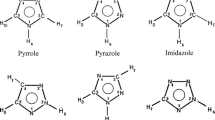Abstract
The UV–vis spectra of 15 naturally occurring flavonoids, including flavones, flavonols, and isoflavones, were simulated and compared to literature experimental results. For this purpose, the TDDFT method in conjunction with the B3LYP-D3 and B3LYP functionals was applied. In spite of some discrepancy between the structural predictions, the differences between the TDDFT/B3LYP and TDDFT/B3LYP-D3 results are negligible. The performance of both functionals in reproducing the UV–vis spectra of the selected flavonoids is satisfactory. The NLMO clusters, i.e. molecular moieties characterised with distinguished electron density, were created. The combined results from the TDDFT and NLMO approaches were employed to perform deep analysis of the spectra. It was found that the transitions from the bonding NLMO clusters to the LUMO cluster are favoured at longer wavelengths, whereas the transitions from the HOMO and HOMO−1 clusters to the antibonding NLMO clusters are favoured at shorter wavelengths. All flavonoids show the HOMO → LUMO and HOMO−1 → LUMO transitions at long wavelengths, and majority of them show the HOMO → LUMO+1 transition at moderate wavelengths. This investigation confirms our earlier finding that the TDDFT and NBO approaches are complementary, implying that the results from the two theories can be combined to better understand the redistribution of electron density upon excitation.




Similar content being viewed by others
References
Andersson K, Malmqvist PÅ, Roos BO (1992) Second-order perturbation theory with a complete active space self-consistent field reference function. J Phys Chem 96:1218–1226
Andresson K, Roos BO (1995) Modern electronic structure theory. World Scientific, Singapore
Anouar EH, Gierschner J, Duroux JL, Trouillas P (2012) UV/Visible spectra of natural polyphenols: a time-dependent density functional theory study. Food Chem 131:79–89. doi:10.1016/j.foodchem.2011.08.034
Becke AD (1993) Density-functional thermochemistry. III. The role of exact exchange. J Phys Chem 98:5648–5652
Boué MS, Carter-Wientjes HC, Shih YB, Cleveland ET (2003) Identification of flavones aglycones and glycosides in soybean pods by liquid chromatography—tandem mass spectrometry. J Chromatogr A 991:61–68. doi:10.1016/S0021-9673(03)00209-7
Casida ME (2009) Time-dependent density-functional theory for molecules and molecular solids. J Mol Struct THEOCHEM 914:3–18. doi:10.1016/j.theochem.2009.08.018
Christiansen O, Koch H, Jørgensen P (1995) Response functions in the CC3 iterative triple excitation model. J Phys Chem 103:7429–7441
Cossi M, Rega N, Scalmani G, Barone V (2003) Energies, structures, and electronic properties of molecules in solution with the C-PCM solvation model. J Comput Chem 24:669–681. doi:10.1002/jcc.10189
Foresman JB, Head-Gordon M, Pople JA, Frisch MJ (1992) Toward a systematic molecular orbital theory for excited states. J Phys Chem 96:135–149
Frisch MJ, Trucks GW, Schlegel HB, Scuseria GE, Robb MA, Cheeseman JR, Scalmani G, Barone V, Mennucci B, Petersson GA et al (2010) Gaussian 09. Revision C.01. Gaussian Inc., Wallingford
Glendening ED, Badenhoop JK, Reed AE, Carpenter E, Bohmann JA, Morales CM, Weinhold F (2001) GENNBO Version 5.0. Theoretical Chemistry Institute, University of Wisconsin, Madison
Grimme S, Antony J, Ehrlich S, Krieg H (2010) A consistent and accurate ab initio parameterization of density functional dispersion correction (DFT-D) for the 94 elements H-Pu. J Phys Chem 132:154104-11–154104-19. doi:10.1063/1.3382344
Hasegawa JYA, Fujimoto K, Swerts B, Miyahara T, Nakatsuji H (2007) Excited states of GFP chromophore and active site studied by the SAC-CI method: effect of protein-environment and mutations. J Comput Chem 28:2443–2452. doi:10.1002/jcc.20667
Kandaswami C, Middleton E Jr (1997) Flavonoids as antioxidants. In: Shahidi F (ed) Natural antioxidants. Chemistry, health effects and practical applications. AOCS Press, Champaign, pp 174–194
Kotzian M, Rösch MN, Zerner MC (1992) Intermediate neglect of differential overlap spectroscopic studies on lanthanide complexes. I. Spectroscopic parametrization and application to diatomic lanthanide oxides LnO (Ln = La, Ce, Gd, and Lu). Theor Chim Acta 81:201–222
Malaj N, De Simone BC, Quartarolo AD, Russo N (2013) Spectrophotometric study of the copigmentation of malvidin 3-O-glugoside with p-coumaric, vanillic and syringic acids. Food Chem 141:3614–3620. doi:10.1016/j.foodchem.2013.06.017
Markharn KR, Mabry TJ (1975) Ultraviolet-visible and proton magnetic resonance spectroscopy of flavonoids. In: Harborne JB, Marby TJ, Marby H (eds) The flavonoids. Springer, Dordrecht, pp 45–77
Marković S, Tošović J (2015) Application of time-dependent density functional and natural bond orbital theories to the UV–vis absorption spectra of some phenolic compounds. J Phys Chem A 119:9352–9362. doi:10.1021/acs.jpca.5b05129
Mazzone G, Toscano M, Russo N (2013) Density functional predictions of antioxidant activity and UV spectral features of nasutin A, isonasutin, ellagic acid, and one of its possible derivatives. J Agric Food Chem 61:9650–9657. doi:10.1021/jf403262k
Perpete EA, Wathelet V, Preat J, Lambert C, Jacquemin D (2006) Toward a theoretical quantitative estimation of the λ max of anthraquinones-based dyes. J Chem Theory Comput 2:434–440. doi:10.1021/ct050287w
Rossi M, Rickles LF, Halpin WA (1986) The crystal and molecular structure of quercetin: a biologically active and naturally occurring flavonoid. Bioorg Chem 14:55–69
Sakata K, Saito N, Honda T (2006) Ab initio study of molecular structures and excited states in anthocyanidins. Tetrahedron 62:3721–3731. doi:10.1016/j.tet.2006.01.081
Stanton JF, Bartlett RJ (1993) The equation of motion coupled-cluster method. A systematic biorthogonal approach to molecular excitation energies, transition probabilities, and excited state properties. J Phys Chem 98:7029–7039
Tsimogiannis DI, Oreopoulou V (2004) Free-radical scavenging and antioxidant activity of 5,7,3',4'-hydroxy-substituted flavonoids. Innov Food Sci Emerg 5:523–528. doi:10.1016/j.ifset.2004.05.006
Tsimogiannis D, Oreopoulou V (2006) The contribution of flavonoid C-ring on the DPPH free radical scavenging efficiency. A kinetic approach for the 3´,4´-hydroxy substituted members. Innov Food Sci Emerg 7:140–146. doi:10.1016/j.ifset.2005.09.001
Weinhold F, Landis CR (2012) Discovering chemistry with natural bond orbitals. Wiley, Hoboken
Zhurko GA, Zhurko DA (2013) Chemcraft 1.7. http://www.chemcraftprog.com
Acknowledgements
This work was partially supported by the Ministry of Science and Technological Development of the Republic of Serbia (Project No. 172016).
Author information
Authors and Affiliations
Corresponding author
Electronic supplementary material
Below is the link to the electronic supplementary material.
Rights and permissions
About this article
Cite this article
Tošović, J., Marković, S. Reproduction and interpretation of the UV–vis spectra of some flavonoids. Chem. Pap. 71, 543–552 (2017). https://doi.org/10.1007/s11696-016-0002-x
Received:
Accepted:
Published:
Issue Date:
DOI: https://doi.org/10.1007/s11696-016-0002-x




